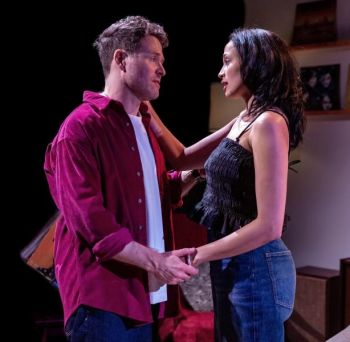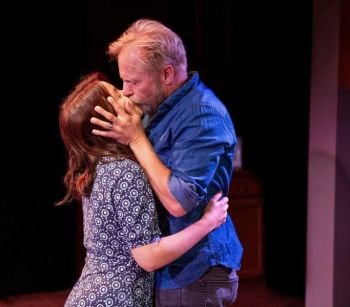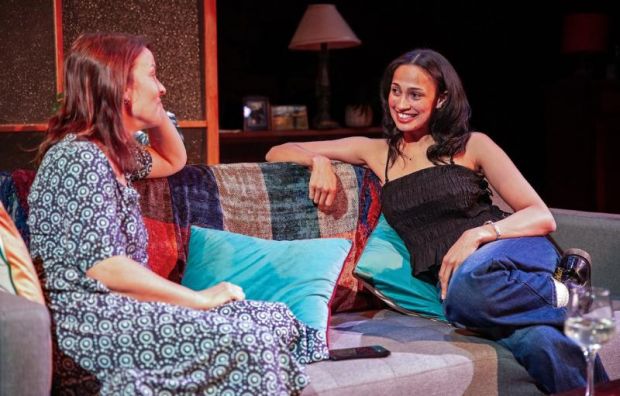So Young
“It’s a story populated not by heroes and villains but by people. Messy, hilarious, infuriating, beautiful people – dealing with the same inevitable changes that life throw at all of us”.
Sam O’Sullivan - Director
 I guess that could describe many plays, but So Young is different. Douglas Maxwell’s “people” expose their strengths and failings in ways that are raw, direct and somehow just a bit funny. Sam O’Sullivan has found that same almost indefinable balance in his direction. The result is a production that is ‘breath holding’ in its intensity. The changes in rhythm, tight pauses, tensions, breaks in tension, the humour, all grow from the perceptive writing of a playwright who really knows the characters he has created – and a director who hears all the nuances in their words – and the spaces between them.
I guess that could describe many plays, but So Young is different. Douglas Maxwell’s “people” expose their strengths and failings in ways that are raw, direct and somehow just a bit funny. Sam O’Sullivan has found that same almost indefinable balance in his direction. The result is a production that is ‘breath holding’ in its intensity. The changes in rhythm, tight pauses, tensions, breaks in tension, the humour, all grow from the perceptive writing of a playwright who really knows the characters he has created – and a director who hears all the nuances in their words – and the spaces between them.
Thus, between Maxwell and O’Sullivan, So Young grabs you. Right from the first moment – and it doesn’t stop. Even between scenes, there is hardly time to catch your breath, or think, before the equilibrium shifts and the balance teeters, and different facets of the characters are revealed.
Maxwell sculpts each character based on the past he gives them and the personality he develops for them. He then puts them together in an unusual situation. This requires a perceptive understanding of how each character will react and the words they will use. In O’Sullivan’s words, Maxwell’s “story cares about all four of its characters and advocates for each point of view passionately”.
 O’Sullivan and his cast have approached the play with similar passion. Studying those characters deeply, understanding them, realising their complexities … and how they explain themselves … so that they come together on stage in a production that is hard to describe in any word other than extraordinary.
O’Sullivan and his cast have approached the play with similar passion. Studying those characters deeply, understanding them, realising their complexities … and how they explain themselves … so that they come together on stage in a production that is hard to describe in any word other than extraordinary.
Jeremy Waters, Ainslie McGlynn and Henry Nixon have a wealth of varied stage and screen experience. Aisha Aidara adds more recent experience and wily astuteness. They bring Maxwell’s characters together in a situation that is caught between what’s past, what is, and what’s to come; between pain and joy; between holding on and letting go; and between honesty and complete candour.
The dialogue is direct, frank, sometimes hurtful, sometimes accusative. Sometimes – because of O’Sullivan’s innate empathy with Maxwell’s intent, and some excellently timed pauses and inflections – even very funny.
O’Sullivan’s eye for balance and distance, and creative use of spaces and shadows (enhanced by Aron Murray’s intuitive lighting) keeps the action taut, the atmosphere edgy, the actors tightly wired – except Aidara who, as Greta, a “cool” twenty-year-old, watches quietly, wisely and knows when to seize her moment.
Aidara has excellent timing – and the ability to realise the impact of stillness and silence – and the dramatic effect of a perfectly delivered line after a perfectly judged pause.

Jeremy Waters and Ainslie McGlynn as married couple Davie and Liane find the seesaw balance of marriage in performances that are plausibly relatable. Waters’ Davie is gruffly cheerful, compliant and disarmingly funny – as opposed to Maths teacher Liane’s stability, directness and sense of what is right.
McGlynn finds that in a performance that is exacting and totally relatable. She sustains a growing despair that eventually erupts passionately … and a little viciously … but is totally understandable. This character is the woman Davie depends on – and the bond between them – and their old friend Milo – is too important to break.

Henry Nixon is Milo, old friend and new lover … and, in one unbelievably moving scene, piercingly percipient bereaved husband. Nixon brings a rare plausibility to this role. There are so many factors that impact on Milo: new love, old friends, expectations of both, and a grief that he wants to keep personal. Nixon controls the way they converge in a performance that is skilfully measured and restrained.
Outhouse – and the Old Fitz – continue to find plays that extend their audiences – and allow artists to keep spreading their creative wings, whether as actors or directors – or designers like Kate Beere who do imaginative things with the intimate stage that is distinctly Old Fitz.
There is not much longer to see this production – and that’s a damn shame because it really needs to be seen.
Carol Wimmer
Photographer: Richard Farland
Subscribe to our E-Newsletter, buy our latest print edition or find a Performing Arts book at Book Nook.

